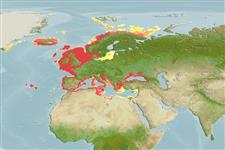Common names from other countries
Environment: milieu / climate zone / depth range / distribution range
Sinh thái học
; Mức độ sâu 0 - 250 m (Ref. 78574). Subtropical; 73°N - 21°N, 33°W - 42°E
Northeast Atlantic and the Mediterranean.
Length at first maturity / Bộ gần gũi / Khối lượng (Trọng lượng) / Age
Maturity: Lm ? range ? - ? cm Max length : 1.0 cm TL con đực/không giới tính; (Ref. 78574)
Collected from the sublittoral zone, from low tide up to a depth of 200 m (Ref. 2754). A microalgae herbivore (Ref. 96488). This is an epibenthic species found on reefs (Ref. 95730). It is one of the most abundant microgastropods inhabiting the alga Gelidium latifolium and prefers to live at the base of the plant (Ref. 96520).
Life cycle and mating behavior
Chín muồi sinh dục | Sự tái sinh sản | Đẻ trứng | Các trứng | Sự sinh sản | Ấu trùng
Members of the order Neotaenioglossa are mostly gonochoric and broadcast spawners. Life cycle: Embryos develop into planktonic trocophore larvae and later into juvenile veligers before becoming fully grown adults.
Demir, M. 2003. (Ref. 2754)
IUCN Red List Status (Ref. 130435)
CITES status (Ref. 108899)
Not Evaluated
Not Evaluated
Human uses
| FishSource |
Các công cụ
Thêm thông tin
Age/Size
Sự sinh trưởng
Length-weight
Length-length
Hình thái học
Ấu trùng
Sự phong phú
Các nguồn internet
Estimates based on models
Preferred temperature
(Ref.
115969): 6.7 - 15.7, mean 9.8 (based on 632 cells).
Vulnerability
Low vulnerability (10 of 100).
Price category
Unknown.
